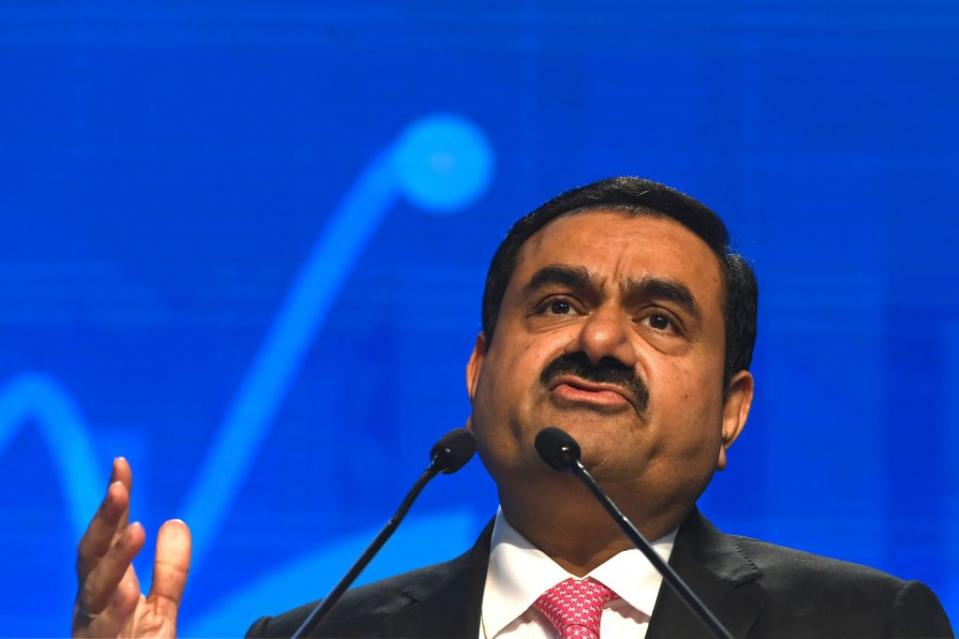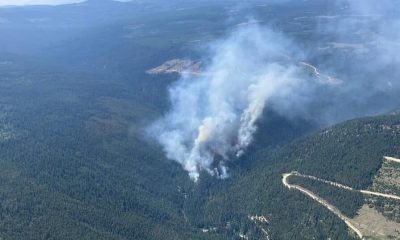Business
India’s Richest Man Accused of Pulling the ‘Largest Con in Corporate History’

Chairperson of Indian conglomerate Adani Group, Gautam Adani, speaks at the World Congress of Accountants in Mumbai on Nov. 19, 2022. Credit – Indranil Mukherjee—AFP via Getty Images
Billionaire Gautam Adani has slipped from being the world’s third richest man to the fourth, after an activist investment firm released a report Tuesday accusing his company, Adani Group, of “brazen” stock manipulation and accounting fraud worth $218 billion, wiping $5.51 billion from his personal net worth by Thursday.
Hindenburg Research, which in the past has shorted—or bet against—companies like electric truck maker Nikola Corp and Twitter, said it holds short positions in Adani companies through U.S.-traded bonds and non-Indian-traded derivative instruments.
Tuesday’s report sent shares tied to seven of the Adani Group’s listed companies falling by more than 5% on Wednesday, taking a $10.8 billion hit, and forcing the company to issue a strong denial of its contents.
Below, what to know about Adani and the corporate corruption allegations.
Who is Gautam Adani?
Gautam Adani is a self-made billionaire, and India’s richest man, with a net worth of roughly $118 billion as of April 2022. Much of this wealth was accumulated during the past three years through his company Adani Group, as the share prices of his key listed companies climbed, pushing the billionaire’s rank to the third-richest man in the world, behind Elon Musk and Jeff Bezos.
The industrialist began as a commodity trader in the 1980s before he founded his company Adani Group in 1988, eventually expanding it into a private infrastructure empire that operates ports, airports, and coal mines across India and the world. The group also has multiple subsidiaries through its data and cable centers and the manufacturing of defense goods. It plans to expand further through a $70 billion investment in green energy businesses in the coming year.
The company’s success has often been linked to lucrative government concessions, thanks to Adani’s close ties with India’s ruling Bharatiya Janata Party. In the past, Adani has been a vocal supporter of Prime Minister Narendra Modi’s vision for a “self-reliant India.”
What do Hindenburg’s findings reveal?
Among other allegations, the report says that Adani Group engaged in stock price manipulation and accounting fraud over the course of decades, and found evidence that the group’s key listed companies fell in value by 85% despite “sky-high valuations.” It also said that substantial debt puts the group on “precarious financial footing.”
The report names several family members—like Gautam Adani’s brothers, Rajesh and Vinod Adani, as well as associates of the Adani Group—for their involvement in major bribery and tax evasion cases. Members of the Adani family have been the subjects of past corruption investigations carried out by the Securities and Exchange Board of India (SEBI) and the Directorate of Review Intelligence. The Hindenburg report also claims that Adani family members allegedly cooperated in the creation of offshore shell entities worth $4.5 billion through forged documents, primarily in tax-haven jurisdictions like Mauritius, the UAE, and the Caribbean islands. Hindenburg said that SEBI was still investigating a case in Mauritius in September 2022, but that no action has been taken against the group so far.
Hindenburg said the report’s findings were based on interviews with dozens of individuals, including former senior executives at Adani Group, thousands of documents, and due diligence site visits in almost half a dozen countries.
How has the Adani Group responded to the allegations?
Adani Group’s chief financial officer Jugeshinder Singh said in an official statement Wednesday that the company was shocked by the report, calling it a “malicious combination of selective misinformation and stale, baseless, and discredited allegations.”
Adani Group did not address specific allegations in its official statement but said it has always been in compliance with the law. The conglomerate also said that the timing of the report suggested malicious intent to “undermine the Adani Group’s reputation with the principal objective of damaging the upcoming follow-on Public Offering from Adani Enterprises,” referring to the group’s plans for increasing the amount of freely traded shares.
On Thursday, Adani Group said in a new statement that it is considering legal action against Hindenburg. “We are evaluating the relevant provisions under US and Indian laws for remedial and punitive action against Hindenburg Research,” said Adani Group Legal Head Jatin Jalundhwala. He added that the report created “volatility in Indian stock markets” that was “of great concern and has led to unwanted anguish for Indian citizens.”
The report was published days before bidding for a $2.5 billion stock sale for Adani’s secondary shares begins Friday, which will include anchor investors like the Abu Dhabi Investment Authority and Morgan Stanley.

Business
What Determines Your Worth to an Employer? The Job Market, or You?

Being paid what you’re worth is a hot topic.
Five anecdotal examples of how employers assess a job’s worth:
- A Vancouver-based software company pays $180,000 for a senior developer role, citing the high cost of living and intense competition for talent.
- A nationwide retail chain compensates its store associates according to regional minimum wage laws rather than their individual skills and experience.
- Even though the ideal candidate must have extensive fundraising expertise, a non-profit organization lowers the salary range for a grant writer position to accommodate the decline in donations.
- A rural manufacturing plant pays its production workers less than their urban counterparts, citing the lower cost of living.
- A consulting firm’s compensation packages for junior analysts include a base salary, bonuses, and stock options designed to attract top graduates.
In the same way, the price of milk, housing, or dog food varies from store to store and region to region; a position’s worth isn’t universal. What’s universal when determining the value of a position is to consider the expected return on investment (ROI) for the employee’s salary:
- Productivity: For production roles, employers estimate the candidate’s potential output, efficiency, and contribution to revenue or cost savings based on their skills, experience, and track record.
- Revenue Generation: For revenue-generating roles, employers predict how the candidate will increase sales, secure new clients, or expand the business.
- Cost Savings: For operational roles, employers estimate the employee’s potential to improve processes, reduce errors, or streamline workflows, quantifying the expected cost savings the candidate will deliver.
- Market Rates: Companies research salary benchmarks for similar roles in their industry and region.
- Affordability (cash flow): How much can the company spend on payroll? (Companies closely monitor their payroll, their largest expense, to keep it from being a “profit distraction.”)
These factors help employers determine what compensation will make the position worthwhile; in other words, the employee adds more value than their salary will cost.
Three key takeaways:
- Employers seek to maximize the ROI on their human capital.
- Candidates are more valuable when they’re seen as synonymous with profits.
- Worth (read: value) in the business world isn’t subjective; it must be proven.
Internet talking heads, trying to appeal to today’s prevalent sense of entitlement, advise job seekers to “demand their worth.” This advice is the cause of the dilemma many job seekers struggle with: Should I base my compensation expectation on what I think I’m worth or what the job market says the job is worth?
Wrong question!
Job seekers should ask themselves, “Should I base my compensation expectation on what I can prove I’m worth or what the job market says the job is worth?”
Always strive to prove what you’re worth, especially during an interview, while considering the following:
Evaluate the job responsibilities.
Expertise-intensive, decision-making-intensive, complex, or business-critical roles garner higher compensation. For instance, senior data scientists earn more than entry-level data analysts.
Additionally, there’s the scope and scale of the role. Directors and managers overseeing multimillion-dollar budgets or large teams are valued more highly than those in smaller managerial roles.
Know the industry standard.
Platforms like Glassdoor, PayScale, and Salary.com, as well as government labour statistics and industry association surveys, provide crowdsourced salary data you can use as a starting point. Even though the objective of proving your worth is to obtain the highest compensation possible, you don’t want to ask for compensation that’s excessively outside the ballpark.
Supply and demand. (a critical factor)
ECON 101: Supply and demand influence price; hence, roles with a limited talent pool and high demand will naturally command a higher salary.
The shortage of certain specialized technical skills, such as cybersecurity or data engineering, increases the cost of hiring those candidates. Conversely, recruiters and talent acquisition specialists are abundant, so employers can be more selective and offer lower salaries.
The employer’s budget. (the most significant determining factor)
Employers aren’t a bottomless pit of money. As much as 70% of a business’s expenses can be attributed to labour costs (wages, benefits, payroll tax). Much like we’re constrained by financial realities when shopping for “whatever,” employers are similarly constrained when hiring.
Organizational size, revenue, profitability, investor and shareholder demands, and strategic priorities are considered when determining a position’s wage. Generally, companies allocate higher compensation budgets to roles essential to achieving their key objectives.
Never base your expectations solely on your own sense of worth. Research industry benchmarks, regional pay trends, and the specific demands of the role. Then, be prepared to discuss and justify the measurable value (key) you can bring to the employer. Highlight your unique skills, experience, and, most importantly, the results you’ve delivered.
- Grew email subscriber list from 300 to 2,000 in 8 months with no budget increase.
- Managed 500+ customer accounts for 5 years without a complaint and got a 98% rating on reviews online.
- Wrote 400+ informative articles, increasing organic website traffic by 21%.
The job market is the primary determinant of a role’s worth—not your personal assessment. (Why should employers be responsible for the lifestyle you created?) A successful job search comes down to convincing an employer that your compensation request will result in a positive ROI.
_____________________________________________________________________
Nick Kossovan, a well-seasoned veteran of the corporate landscape, offers “unsweetened” job search advice. You can send Nick your questions to artoffindingwork@gmail.com.
Business
Before Spending Money on a ‘Career Coach,’ Do Yourself a Favour, First Try These Job Search Strategies

I’m sure you’re aware of the “career coaching” industry—Internet talking heads promising job search and career success—that’s sprung up in recent years. Worth noting: The industry is unregulated. All career coaches are self-proclaimed; no certification or licensing is required.
Career coaches have one ultimate goal: To make money off you.
Today’s tight job market is making job seekers frustrated and desperate, which career coaches are taking advantage of with their promise of insider knowledge, personalized guidance, and a direct line to the hidden job market. Career coaches market themselves as a shortcut to finding a job, which is appealing when you’ve been unemployed for a while.
I’m not averse to hiring a career coach to assist you with your job search; it’s your money. However, keep in mind a career coach…
- is a significant expense, especially if you’re unemployed
- will only offer common sense advice, nothing that you probably already don’t know or haven’t read or heard before, and
- doesn’t have insider knowledge
…and you’ll still need to do the activities related to job searching.
When asked, “Nick, should I hire a career coach?” my answer is an unequivocal “No!” Conducting your job search solo will not only save you money, you’ll also be developing job search skills you’ll need for the next time—chances are there’ll be a next time—you’re job hunting. Before spending thousands of dollars on a career coach, I suggest first trying the following job search strategies.
Optimize your online presence.
In today’s digital-first job market, employers will check your online digital footprint to evaluate your candidacy; are your interview-worthy? Start with the obvious: Ensure your LinkedIn profile is up-to-date and showcases your quantified accomplishments (a non-quantified statement is an opinion) so employers can see the value you can add. Do yourself a favour, read LinkedIn Mastery: A Comprehensive Guide to Navigating Digital Landscapes Effectively, by Benjamin Stone.
Necessary: Stay active on LinkedIn!
Your LinkedIn profile can’t be non-active. Maximizing LinkedIn’s potential requires regularly engaging with content, commenting on posts, and contributing original content. Engaging actively and visibly on LinkedIn will lead to opportunities.
Next:
- List your social media accounts.
- Deactivate accounts you are no longer using.
- Set any accounts you don’t want prospective employers or recruiters to see to private.
- Ensure your social media profiles (g., display name, handle, headshot, bio) convey the same message about your professional background.
Leverage your existing network (a low-hanging fruit few job seekers take advantage of).
Everyone has a network of some sort. This means since all job opportunities are attached to people—good news—there are job opportunities all around you. Often, your barista, dentist, hairstylist, neighbours, fellow members of whatever club or association you’re a part of, and, of course, family and friends can help open doors for you.
Tell everyone you know that you’re looking for a new job. Always carry extra copies of your resume and hand them out when appropriate. You’ll be surprised at the number of people willing to help you when they understand your situation.
Read these two books:
- Never Eat Alone, by Keith Ferrazzi
Ferrazzi outlines practical strategies for building relationships, networking, and leveraging connections
.
- Finish What You Start, by Peter Hollins
Hollins provides actionable strategies for achieving your job search and career goals, such as overcoming procrastination and boosting productivity with focus and discipline.
Apply less, connect more.
Applying online is a waste of time. In previous columns, I’ve noted that applying online is comparable to playing the lottery; you’re hoping a stranger hires you. Numerous studies have shown that most jobs aren’t advertised; they’re filled through connections and referrals.
Job searching today is a long game; you need to be patient. Today, you need to network your way into a company and identify opportunities, which no career coach can do for you. It’s unlikely the resume you submit online will be reviewed. Paying to have your resume redesigned won’t get it more views; getting it in front of people who can hire you will.
Take what you will from the following.
A few months back, a job seeker asked me, “I’ve been working as a help desk agent at a healthcare software company for five years. I want to become a Director of IT at a large multinational company. What should I do?”
How should I know? I’m not a Director of IT. Why not ask the Director of IT at a large multinational company?
Take advantage of the fact that people love talking about themselves. Dinner with someone who holds the position you aspire to is a better investment than hiring a career coach who lacks your dinner partner’s real-world experience. I charted my career path by observing those ahead of me and seeking their advice. Talking to people who are where you want to be will benefit your job search and help you achieve your career aspirations.
By shifting your mindset, optimizing your online presence, leveraging your existing network, staying engaged on LinkedIn, and connecting with the right people, you won’t need to hire a costly career coach, and you’ll develop skills you can use throughout your career.
_____________________________________________________________________
Nick Kossovan, a well-seasoned veteran of the corporate landscape, offers “unsweetened” job search advice. You can send Nick your questions to artoffindingwork@gmail.com.
Business
How to Start a Business?

Market Research
You have to conduct research on the whole market and find out the gap. This gap will be your opportunity. Moreover, this research will give you an idea of how different businesses work and how they fulfill the needs of the people. Businesses work due to the demand for their products and services in the market. So, through this research, you have to collect information about the following things:
- Demand
- Market size
- Economic indicators
- Location
- Market saturation
- Pricing
You can use surveys, questionnaires, and focus group interviews to extract information on the above factors.
Business Plan
Develop a complete roadmap for your business. This plan should cover all the details from the manufacturing to the sales and pricing.
It has a summary of the complete execution of the company, including the mission of the company, product or service of the company, competitors of the company, management, and employees of the company, as well as the location of the company. This plan should be in such a way that everyone can easily understand.
Investment For Business
If you are not self-funded, then you will need investment for your business. There are several ways to find investment, such as the following:
● Venture capital
You can offer the shares of the company in exchange for shares of the company. In the beginning, you have to offer the company ownership to finance your project.
● Crowdfunding
In this type of investment, a large number of people give funds to the startup. They are not given shares and profits from the company. However, the company provides them with gifts in the future for their finances.
● Loans
There are many government and private companies that are offering loans for small and large companies. For this loan, you have to prepare a business plan, expense sheet, and expected profits. You can find several companies that are providing loans for businesses, such as Lendforall, Baker Tilly, West Bank Union, etc.
Structure of Business
Before starting a business, you have to select its structure. Traditionally, you will find the following structures of business:
- Sole proprietorship
- Partnership
- Limited Liability Company
- Corporation
To select any structure, you must analyze and compare your business with others. You will get an idea of which structure will be the most suitable for your business.
Business Tools
Nowadays, there are several business tools available in the market. These tools have made business management easy to a great extent. However, you have to invest in these tools to compete the market. Here are some important tools for business:
- Accounting software
- Customer relationship management software
- Project management software
- Credit card processor
- Point of sale
- Virtual private network
Many other tools are available in the market that are used for different management purposes.
Registration of Business
You have to register your business with the federal government. Moreover, you should apply for the insurance for your business. There are many other documents, such as tax IDs from federal and state governments, licenses and permits for your business, and applying for a business bank account.
-

 News8 hours ago
News8 hours agoAfter grind of MLS regular season, Toronto FC looks forward to Leagues Cup challenge
-

 News23 hours ago
News23 hours agoCanadaNewsMedia news July 26, 2024: B.C. crews wary of winds boosting wildfires
-

 News9 hours ago
News9 hours agoIn President Milei’s sit-down with Macron, Argentina says the leaders get past soccer chant fallout
-

 News14 hours ago
News14 hours agoOntario expanding access to RSV vaccines for young children, pregnant women
-

 News7 hours ago
News7 hours agoUmicore suspends construction of $2.76B battery materials plant in Ontario
-

 News22 hours ago
News22 hours agoPeople should stay inside, filter indoor air amid wildfire smoke, respirologist says
-

 News18 hours ago
News18 hours agoSuspected train sabotage, bad weather dampen spirits ahead of Paris opening ceremony
-

 News24 hours ago
News24 hours agoFrench train lines hit by ‘malicious acts’ disrupting traffic ahead of Olympics, rail company says





















